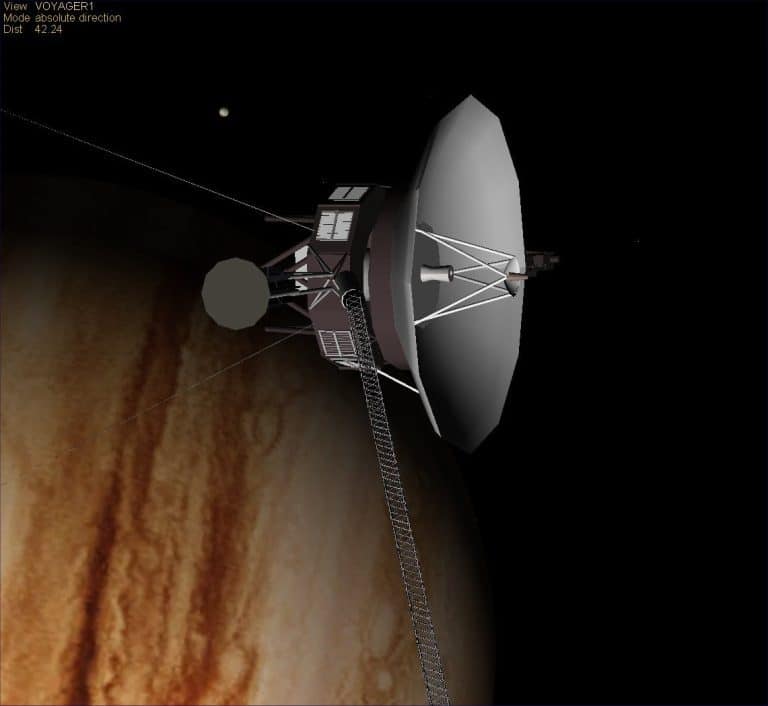Over the history of space exploration, scientists have launched many exciting missions, but few have been active for such a long time as Voyager 1. Launched in 1977, the spacecraft has been roaming deep space ever since and even today, the probe is still transmitting data.
Considering that Voyager 1 location is now over 20 billion km away from our planet, the sheer distance and mission timespan already make this spacecraft unique. The Voyager 1 end date may be near, though, because its power supplies gradually run out.
But before that happens, let’s find out more about the Voyager 1 location and the details of this outstanding mission that exceeded all scientists’ expectations.
Voyager 1 Mission Details
What is a fast fact about Voyager 1? That it was launched 16 days after Voyager 2! And this was not a mistake or a necessary adjustment — both probes were travelling towards Jupiter and were numbered by order of reaching their destination. Since Voyager 1 was assigned a shorter trajectory, it would reach the gas giant four months earlier than the second probe.
The mission took off on September 5, 1977, and has been running ever since — even though most of the original goals have long been accomplished. Voyager 1 speed at launch was 17 km/s, which made it possible for the spacecraft to reach Jupiter in January 1979 and Saturn — in November 1980. So, the probe is not only the furthest spacecraft ever launched by humanity — it is also the fastest-travelling artificial object in space.
Still, the high speed and the distant Voyager 1 location from Earth are not the mission’s primary achievements. The probe helped NASA make a series of important discoveries — it took the first pictures of Jupiter’s ring system and discovered two of its satellites, Thebe and Metis, that were not visible through telescopes at the time.
When the probe reached Saturn, it discovered three more satellites not known before — Pandora, Prometheus, and Atlas. It also sent very important readings about plasma in interstellar space. And finally, we owe one of the most ‘famous’ pictures of our planet, A Pale Blue Dot, to the Voyager 1 spacecraft. Quite impressive for a single probe, is it not?
Voyager 1 How it Works
Despite its impressive service span, Voyager 1 has a relatively standard structure as far as spacecraft design is concerned. The cylindrical probe is equipped with an antenna, one of which is always pointing towards the Earth, several onboard computers, and a series of electric generators. In addition, the probe carries cameras and several scientific instruments, including a magnetometer.
So, what keeps Voyager 1 moving? The spacecraft has several thrusters that can be adjusted from Earth. According to Orbital Today, though, it takes about 22.5 hours for the commands to reach the spacecraft, which is why NASA only resorts to this as a final measure.
For example, thrusters were once adjusted in 1982 to ensure the spacecraft stayed on the right trajectory that would eventually allow it to leave the solar system. This, however, will not happen in the next 30,000 years, considering the enormous space distances.
Where is the location of Voyager 1?
The probe is still moving, so it does not have a fixed location. Even more, NASA only has an approximate location — right now, it is in the constellation Ophiuchus, around 24.2 billion km away from Earth and moving farther away.
Even though it is technically possible to calculate the exact Voyager 1 location based on the probe’s trajectory, the enormous distances between the spacecraft and its ‘home’ planet mean that we cannot ‘catch up’ with the probe even if we want to.
On February 17, 1998, Voyager 1 officially became the fastest probe sent to space — it was then that it overtook Pioneer 10, another research probe launched to Jupiter in 1972. So, what is the speed of Voyager 1? Right now, scientists only have data about its original speed at launch — 17 km/s or 61,200 km/h! However, this speed is not constant — the gravitational forces of planets it passes may affect this speed. This is another reason why no one can track Voyager 1 location in real-time — we only have approximate calculations.
How Far Will It Go?
This is another question that does not yet have an exact answer. In August 2012, Voyager 1 became the first spacecraft to reach interstellar space. This, in turn, has caused some confusion in the media as many sources in 2013 started reporting that the probe had left our solar system.
While such a thing is technically possible, it would take the probe another 30,000 years to reach the end of our solar system and another 100,000 years to travel beyond the Milky Way Galaxy — assuming it still moves with its estimated speed of 17 km/s, which can slow down due to other planets’ gravitational pull or any other unforeseen encounters. The latter is unlikely, though — the distances in space are so vast that a chance meeting with another object is very improbable.
Is There an End to Voyager 1 Mission?
Voyager 1 has already completed all of its set goals and exceeded NASA’s boldest expectations. And yet, the veteran is still transmitting data — in 2021, NASA received recordings of interstellar sounds and the measurements of matter density. In 2022, there was a short disruption in communication, which was soon fixed.
NASA also reports that the probe’s power supply is used as rationally as possible and should suffice until 2025 at least. But even when it runs out, Voyager 1 might still serve a different purpose as it drifts further and further away. The probe is carrying a Golden Record with a message in 50 different languages, the sounds of music, Earthly nature, and a few other terrestrial souvenirs, such as pictures of cars and aircraft.
Even though the idea of possibly contacting other civilisations has its opponents, Voyager 1 is supposed to carry out a diplomatic mission — forever and ever, until someone, somewhere far in the Universe, discovers our message and possibly even deciphers it.










